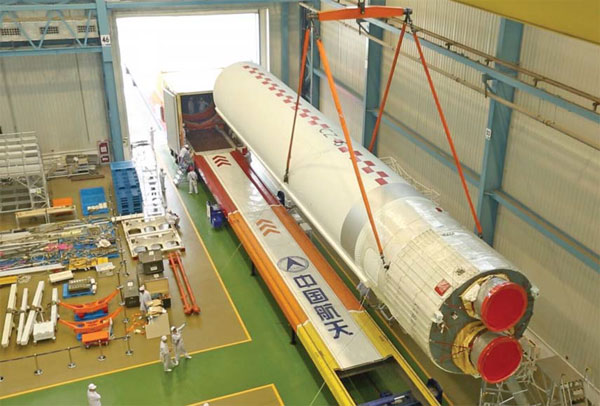Heavy carrier rocket shoots for moon, Mars
China will conduct the first launch of its heavy-lift Long March 5 carrier rocket this year and will use it to transport a manned space station into orbit in the near future.
The maiden flight of the nation's strongest and most technologically advanced launch vehicle will take place at the Wenchang Space Launch Center in the island province of Hainan.
With a takeoff weight of 869 metric tons, it can lift a 25-ton payload into low Earth orbit, or a 14-ton payload into a geosynchronous transfer orbit.
|
A Long March 5 carrier rocket is lifted in preparation for transport to Wenchang Space Launch Center in August. He Chao / Xinhua |
The Long March 5 will be tasked with launching heavyweight spacecraft including the Chang'e 5 lunar probe, major parts of the planned space station and Mars probes, according to officials at the China Academy of Launch Vehicle Technology.
Chinese scientists and engineers are now developing a permanent manned space station, which is to be built in space from 2018 and will be put into service around 2022. It will consist of three parts: a core module attached to two space labs, each weighing about 20 tons.
The facility is expected to become the world's only space station after the International Space Station is retired in 2024.
According to the academy, the Long March 5 will use liquid oxygen-kerosene and liquid oxygen-liquid hydrogen as propellants for its engines, which means the gigantic rocket will be friendlier to the environment than previous versions.
It has taken researchers 10 years to develop the rocket after nearly 7,000 tests, the academy says, adding that engineers will develop six configurations for the Long March 5 family, with each having different launch capacities.
The academy has also begun to develop a superheavy rocket that will have a takeoff weight of 3,000 tons and can thrust a 100-ton payload into low Earth orbit.
If research and development go as planned, the rocket will carry out its first flight in around 2030 and will enable China to carry out manned missions to the moon and to send and retrieve Mars probes, according to the academy.
Lieutenant General Zhang Yulin, deputy head of the Central Military Commission's Equipment Development Department, said in April that the nation will strive over the next 15 to 20 years to land astronauts on the moon.
China has sent 10 spacecraft and 10 astronauts into space and will soon fulfill a manned mission to transport two astronauts to a space laboratory. The nation has also made three lunar exploration missions, including one that soft-landed a rover on the moon.
The country will also send an unmanned probe to Mars to orbit and land on the red planet around 2020, the Chinese space authority says.



















